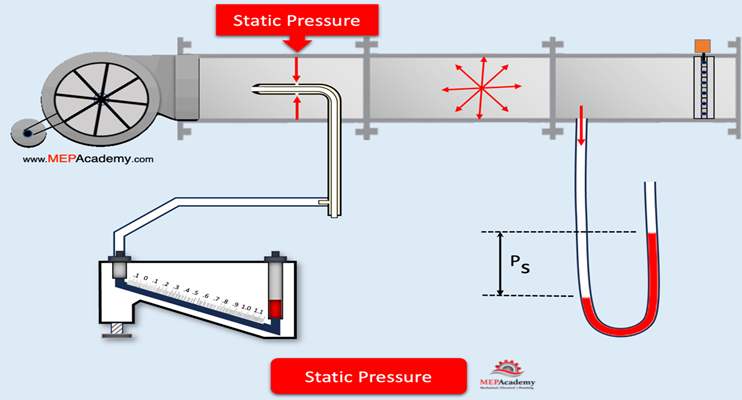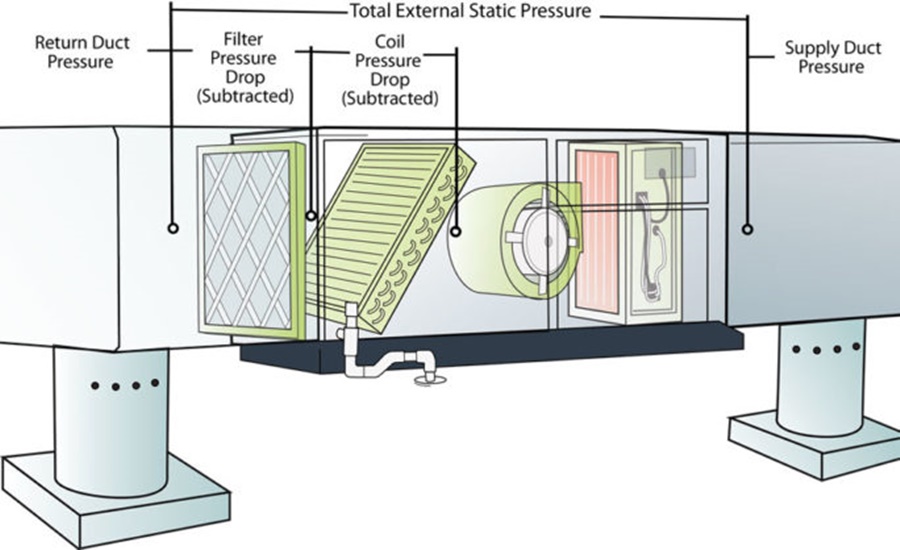In the world of HVAC (Heating, Ventilation, and Air Conditioning), ensuring that systems are running efficiently is crucial for both comfort and energy savings. One of the key parameters that determine HVAC system efficiency is static pressure. Static pressure, a measure of the air resistance within the ducts, is essential to understand when designing, operating, or troubleshooting HVAC systems. This article will guide you through the process of calculating static pressure in an HVAC system, explaining its importance and offering practical steps to measure and manage it effectively.

Understanding Static Pressure in HVAC Systems
Before diving into how to calculate static pressure, it’s important to first understand what static pressure is and why it matters. Static pressure refers to the resistance encountered by the air as it moves through the ductwork in an HVAC system. This pressure affects the performance of your system and can influence airflow, energy efficiency, and the overall comfort level of a space.
Static pressure is typically expressed in inches of water column (in. wc) or Pascal (Pa), with one inch of water column equaling about 249 pascals. Proper static pressure ensures that air flows efficiently through ducts without excessive strain on the fan or blower, thereby improving the HVAC system’s longevity and performance.
Types of Static Pressure
1. Supply Static Pressure: The resistance to airflow within the supply side of the HVAC system, moving conditioned air from the furnace, air handler, or cooling coil into the ducts and into the living space.
2. Return Static Pressure: The resistance faced by the return air as it moves from the living space back to the air handling unit or furnace.
3. Total Static Pressure: The sum of both the supply and return static pressure in the system.
Why Calculating Static Pressure is Important
Calculating static pressure in an HVAC system is critical for several reasons:
System Efficiency: If static pressure is too high or too low, the system may not operate at peak efficiency, leading to higher energy consumption and increased operational costs.
Proper Sizing of Equipment: Incorrect static pressure calculations can lead to improperly sized HVAC components, such as fans, ductwork, and filters, which can cause inefficient airflow and reduce the system’s ability to maintain consistent comfort levels.
Preventing System Failures: Excessive static pressure can cause stress on the system, potentially leading to premature failure of critical components like fans or motors.
How to Measure Static Pressure in an HVAC System
To calculate static pressure in an HVAC system, you need the right tools and a clear process. Typically, a manometer or differential pressure gauge is used to measure static pressure. Here’s how to go about it:
1. Gather the Necessary Tools
Manometer or Differential Pressure Gauge: This tool will measure the pressure in the ductwork.
Static Pressure Probe: A probe with a small hole that is used to measure the pressure at different points within the ducts.
Drill (optional): If there are no pre-existing holes, a drill will be necessary to insert the static pressure probe.
2. Prepare the HVAC System
Turn on the System: Ensure the HVAC system is running at its normal operating condition. This allows you to measure the static pressure under typical load conditions.
Check the Ducts: Before taking any readings, inspect the ducts for any visible leaks or blockages. These can influence your readings and indicate potential issues with the system.
3. Measure Supply Static Pressure
To measure the supply static pressure:
Insert the static pressure probe into the ductwork, making sure it is positioned about 6 inches away from the furnace or air handler.
Record the reading shown on the manometer. This is your supply static pressure.
4. Measure Return Static Pressure
For return static pressure, repeat the process by inserting the probe into the return ductwork. Ensure that it is at least 6 inches away from the return grille to get an accurate reading.
5. Calculate Total Static Pressure
Once you have both the supply and return static pressure readings, add them together to get the total static pressure in the system.
Ideal Static Pressure Levels for HVAC Systems
Knowing what constitutes an ideal static pressure is key to ensuring your HVAC system operates effectively. Here are some general guidelines for static pressure levels in residential HVAC systems:
Supply Static Pressure: Ideally, this should fall within the range of 0.5 to 1.0 inches of water column for optimal airflow.
Return Static Pressure: This should generally be in the range of 0.5 to 0.8 inches of water column.
Total Static Pressure: A well-balanced system should have a total static pressure of between 1.0 to 1.5 inches of water column. If the total static pressure exceeds this value, it may indicate that there are blockages or restrictions in the ducts.
However, these numbers can vary depending on the specific design and size of the HVAC system, so always refer to manufacturer guidelines or consult with an HVAC professional for more accurate recommendations.
How to Adjust Static Pressure in an HVAC System
If your system’s static pressure is too high or low, adjustments are necessary to ensure optimal performance. Here’s how you can do that:
Reducing High Static Pressure
High static pressure can be a sign that your ducts are too small, or there are obstructions such as dirty filters or a clogged air handler. To reduce high static pressure:
Increase Duct Size: If the ducts are too small for the airflow required by the system, consider resizing them.
Clean or Replace Filters: A clogged filter can significantly increase static pressure. Replace or clean filters regularly.
Remove Obstructions: Inspect the ductwork for blockages, such as dirt, debris, or damaged sections, and remove them promptly.
Increasing Low Static Pressure
Low static pressure may be due to oversized ducts, underperforming fans, or insufficient airflow. To increase low static pressure:
Adjust Fan Speed: Increasing the fan speed may help raise static pressure, but ensure that the fan is rated for higher pressure levels.
Close Unused Vents: If there are too many open vents, closing some may help redirect airflow and increase pressure.
Troubleshooting Static Pressure Issues
Here are some common static pressure issues and their potential solutions:
1. High Static Pressure
Symptoms: Airflow is weak, system is noisy, and there’s excessive energy consumption.
Solutions: Check for dirty filters, blocked ducts, or improperly sized ducts.
2. Low Static Pressure
Symptoms: Inconsistent temperatures and poor air distribution.
Solutions: Ensure the fan is operating correctly, and the ductwork is sealed and sized correctly.
Conclusion
Understanding how to calculate and manage static pressure in HVAC systems is crucial for ensuring that your system operates efficiently, saving both energy and costs. By following the steps outlined in this article, you can measure static pressure accurately and make the necessary adjustments to optimize your system’s performance.
